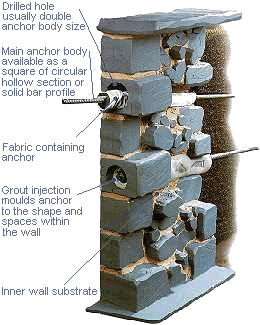
The intrinsic qualities of the Cintec™ fire resistant. The intrinsic qualities of the Cintec™ fire resistant anchor are well documented through years of extensive testing. In-house research by destructive testing has produced a wealth of information for its shear and tensile capabilities. A booklet of this data is available on request. An independent study carried out by Building Research Establishment involved accelerated age testing. This simulated a forty year aging cycle and confirmed the anchors long term performance. The system was also subjected to a destructive fire test, after two hours at 1200°C the anchor still functioned normally.
Running parallel to the anchor research are studies for its engineering applications and the effects upon the structures in which it is installed. Independent analysis has involved the destruction of masonry walls in a series of Shaking Table Tests carried out by the University of Southampton. The final report concluded that the point of failure was dependent upon the strength of the original masonry but in all cases the introduction of lateral restraints in the form of Cintec™ stitching anchors increased the failure load by at least a factor of two. Such research is proving invaluable for projects in zones susceptible to earthquakes. Future applications are limited only by one’s imagination.
A European Commission grant is enabling research into a ‘Smart Anchor’ capable of detecting movement within a structure as well as the moisture content of the parent material. Other avenues of exploration include multi-bar anchors, safety anchors and even a human bone anchor.
Perhaps the most spectacular analysis so far was conducted at TRL (the Transport Research Laboratory). It involved the test to destruction of a three ring brick masonry arch, built to simulate those often found along the trunk roads of the UK. After the insertion of Cintec™ anchors its load bearing capacity was more than doubled compared to a pervious test conducted on an identical but un-strengthened bridge. This research heralded the creation of Archtec. The work has inevitably had positive repercussions not only for bridges but for tunnels, vaulted ceilings and dams. These are promising lines of study now backed by European funding under the title of the Defiant Project.


